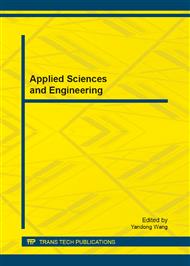[1]
Arunava De, Rajib Lochan Das, Anup Kumar Bhattacharjee, Deepak Sharma: Masking based segmentation of diseased MRI images, International Conference on Information Science and Applications, ICISA 2010 proceedings, IEEE Seoul chapter, Seoul, Korea, pp.230-236.
DOI: 10.1109/icisa.2010.5480274
Google Scholar
[2]
T. Pun: Entropic thresholding: a new approach, CVGIP: Graphical Models Image Process., vol. 16, p.210–239, (1981).
Google Scholar
[3]
C.H. Li and C.K. Lee: Minimum cross entropy thresholding, Pattern Recognition , vol. 26, no. 4 , p.617– 625, (1993).
DOI: 10.1016/0031-3203(93)90115-d
Google Scholar
[4]
H.D. Cheng, J.R. Chen and J.G. Li: Threshold selection based on fuzzy c-partition entropy approach, Pattern Recognition , vol . 31, no . 7, pp . 857–870, (1998).
DOI: 10.1016/s0031-3203(97)00113-1
Google Scholar
[5]
P.K. Saha and J.K. Udupa: Optimum image thresholding via class uncertainty and region homogeneity, IEEE Trans. Pattern Anal. Mach. Intell. , vol . 23, no . 7, pp . 689–706, (2001).
DOI: 10.1109/34.935844
Google Scholar
[6]
N. Otsu: A thresholding selection method from gray- level histograms, IEEE Trans. Syst. Man Cybern, vol . 9, no . 1, pp . 62–66, (1979).
DOI: 10.1109/tsmc.1979.4310076
Google Scholar
[7]
J. Kittler and J. Illingworth: On threshold selection using clustering criteria, IEEE Trans. Syst. Man Cybern., vol . 15, no . 5, pp . 652–655, (1985).
DOI: 10.1109/tsmc.1985.6313443
Google Scholar
[8]
Q. Hu,Z. Hou and W.L. Nowinski: Supervised range-constrained thresholding, IEEE Trans. Image Process, vol . 15, no . 1, pp . 228–240, (2006).
DOI: 10.1109/tip.2005.860348
Google Scholar
[9]
Y. Qiao, Q. Hu, G. Qian, S. Luo, and W. L. Nowinski: Thresholding based on variance and intensity contrast, Pattern Recognition, vol. 40, p.596 – 608, (2007).
DOI: 10.1016/j.patcog.2006.04.027
Google Scholar
[10]
Y. Kabir, M. Dojat, B. Scherrer,F. Forbes,C. Garbay: Multimodal MRI Segmentation of Ischemic Stroke lesions , Proceedings of the 29 thAnnual International Conference of the IEEE EMBS, Cite Internationale, Lyon France, August 23-26, (2007).
DOI: 10.1109/iembs.2007.4352610
Google Scholar
[11]
Zhu, H., Brown, R.A., Villanueva, R.J., Villanueva-Oller, J., Lauzon, M.L., Mitchell, J.R. and Law, A.G.: Progressive imaging: S-transform order. ANZIAM J. v45 iE. C1002-C1016.
DOI: 10.21914/anziamj.v45i0.937
Google Scholar
[12]
R.C. Gonzalez, R.E. Woods: Digital Image Processing, p.392, 472-477, Second Edition, Prentice Hall India, (2002).
Google Scholar
[13]
MacQueen, J.B.: Some methods for classification and analysis of multivariate observations, In: Proceedings of 5th Berkeley Symposium on Mathematical Statistics and Probability, University of California Press, Berkeley, CA, p.281–297, (1967).
Google Scholar
[14]
R.O. Duda, P. E. Hart, D .G. Stork : Pattern Classification, pp.526-528, Second Edition, John Wiley and Sons, (2004).
Google Scholar


